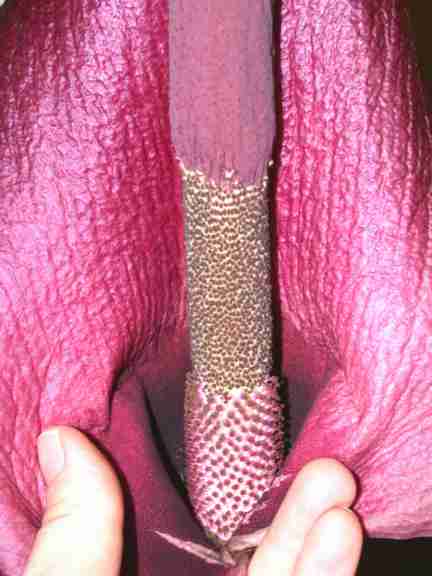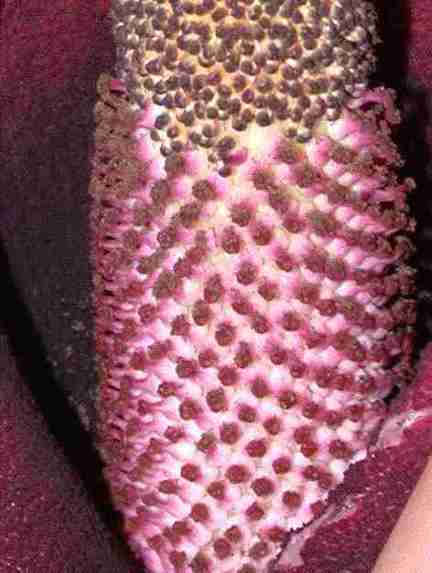

|
|
Biology Photo of the Month - February 2002Amorphophallus konjac(photos by Bill Capman)
Nearly every year at about this time, Augsburg biology students get to experience one of the smells of the tropics, but this particular scent is unlikely to show up any time soon on the perfume counter. This is not one of the sweet smells we often associate with tropical flowers, but rather the powerful scent of rotting carrion! The source of this smell, Amorphophallus konjac, is a member of the aroid family (Araceae), the same family as familiar plants such as Philodendron and jack in the pulpit. This plant from Southern China and Vietnam produces a powerful scent mimicking the odor of a rotting dead animal. This odor is irresistable to carrion-feeding insects, which are tricked into visiting the flowers and transporting the pollen by the false promise that the flowers are good places to obtain food and/or lay eggs. Most likely, the deceit is enhanced by the dark brownish purple rotting flesh color. Amorphophallus is not alone in carrying out this sort of deceit. In fact, a variety of other plants have flowers that are less than pleasant smelling. Examples include the related skunk cabbage, and the unrelated wild ginger, both of which grow wild in North America. This Amorphophallus plant spends its summers in Dr. Bill Capman's backyard. During the growing season it produces one huge leaf, at least 3 feet tall and at least as wide, which vaguely resembles a small palm tree (see link to photo below). It is quite attractive and exotic looking, and one would never guess its reproductive behavior by looking at it during the summer. In the fall, the plant goes dormant, and its huge tuber sits indoors in its pot in perfectly dry soil until the following May, when it goes back outside. Midway through this dry, dormant period the tuber sends up a rapidly growing flowering shoot, which develops in a matter of a very few weeks into the infloresence seen here. The blooming period last only a few days. The water for this growth all comes from water stored in the tuber, and presumably, from the water produced by cellular respiration as the plant burns stored food in the tuber to provide the energy for this rapid growth. The stench from this plant is truly impressive. So impressive that the plant is relegated to a position next to a fume hood during the peak of its blooming (see below)! |
 |
The huge "flower" of Amorphophallus is not actually single flower, but rather an inflorescence. In this photo and in the closeup below, the numerous small male flowers releasing dark pollen are above, and the lighter colored female flowers are below. (Note that the first photo at the top of this page was taken a few days earlier and the male flowers are white because they had not yet released pollen). The amazing scent is produced from the large purplish structure that extends above the male flowers. |

Amorphophallus konjac has lots of company within its own genus, it being just one of roughly 170 species of Amoprphophallus which grow in the old world tropics. While our Amorphophallus is a large plant, some of its relatives are downright enormous, with inflorescences exceeding 10 feet in height, and leaves up to 20 feet tall. When one of these huge species blooms in a botanical garden the event usually makes the international news.
The following links have interesting information and photos regarding several such events:
http://www.huntington.org/BotanicalDiv/TitanIntro.htm
http://www.fairchildgarden.org/blooms/Agigas.html
Note: The following photo from the above site includes several plants in their vegetative stages...the tall green plant on the right side of this photo is some species of Amorphophallus that looks just like an oversized version of Amorphophallus konjac: http://www.fairchildgarden.org/images/Agigas61.jpg What you are seeing here is the one single giant leaf that grows from the Amorphophallus tuber.
The following link gives a great deal of additional information on the genus Amorphophallus and its many species:
http://www.aroid.org/genera/amorphophallus/amorph.html